Essex
Explore hidden histories, historic photos, and things you never knew about Essex from the collections and archives of Historic England.
Discover your local listed buildings and places
Introducing some of Essex's most historic sites, included in the National Heritage List for England. Some of these captions have been summarised by AI. Click through for the official List entry. Skip this section and go to place by numbers
Langleys
Great Waltham
Langleys features late 19th-century gardens and early 18th-century parkland with designs by Charles Bridgeman and updates possibly by Humphry Repton. It has remained privately owned.
Faulkbourne Hall
Faulkbourne
Faulkbourne Hall, dating from 1439, is a historically significant red-brick mansion. It witnessed royal visits and extensive garden and estate developments across centuries.
Walden Castle
Saffron Walden
This remnant of a tower in Saffron Walden, Uttlesford, dates from the late 11th or early 12th centuries.
Shortgrove Hall
Debden
Shortgrove Hall's landscape, designed by Lancelot Brown, features historic gardens and parkland originating from the 18th century and developed further by William Chater in the 19th century.
War memorials at Dollyman's Farm
Wickford
Two war memorials, erected around 1920, dedicated to two British pilots killed in service at this site during the First World War.
Cold War Heavy Anti-aircraft gun site, 330m and 220m nort…
Roydon
The Cold War Heavy Anti-aircraft gun site showcases England's defense strategy against atomic threats, preserving key features for historical insight.
The Dovercourt lighthouses and causeway
Harwich
The Dovercourt Lighthouses, built in 1862, are notable for their prefabricated design and use of screw pile foundations, marking a milestone in lighthouse history.
Coopersale House
Epping
Coopersale House, built by John Archer in the late 17th century, features landscape work by Adam Holt. Lancelot Brown was consulted, but his involvement remains unclear.
Roman Catholic Church of Our Lady of Fatima
Harlow
Roman Catholic parish church, designed in 1953-1954 by Gerard Goalen, built in 1958-1960, with stained glass designed and made by Dom Charles Norris of Buckland Abbey, assisted by Dom...
Harwich Train Ferry Berth
Harwich
Train ferry berth, erected in 1923 by the London and North Eastern Railway, utilising components from the train ferry berths constructed at Richborough and Southampton in 1917, probably by...
A London mobilisation centre known as the North Weald Red…
Bobbingworth
North Weald Redoubt is a significant late 19th-century military site used as a radio station post-World War I, retaining original structures and historical military features.
Chain Home tower at Great Baddow
Great Baddow
Chain Home tower, originally erected at RAF Canewdon in south-east Essex in 1937, relocated to Great Baddow in 1956.
Beaumont Quay, Hamford Water: a 19th century quay and lim…
Beaumont-cum-Moze
The 19th-century Beaumont Quay features a rare East Anglian lime kiln, storehouse remnants, and a maritime trade history. It represents regional lime industry diversity and preservation.
Colchester Castle and the Temple of Claudius
Colchester
A multi-period site encompassing part of a Roman legionary annexe, part of a Roman colony, a classical temple known as the Temple of Claudius, a late Anglo-Saxon or Norman chapel and...
Saling Grove
The Salings
Park and pleasure ground for which Humphry Repton produced a Red Book in 1790, with subsequent mid-C19 and late C20 additions.
Plumberow Mount
Hockley
Plumberow Mount is a well-preserved, rare Roman barrow, likely from the first century AD, potentially holding intact primary burials, and featuring later Anglo-Saxon burial activity.
Tudor blockhouse 300m south of Mersea Stone
East Mersea
The Tudor blockhouse near Mersea Stone is a historically significant, earthwork-surviving military structure in Essex, illustrating 16th-century defensive tactics, and built with earth and...
Multi-period site at Norsey Wood
Billericay
Norsey Wood features significant Bronze Age barrows, Iron Age urnfields, Roman ceremonial sites, and medieval deer banks, highlighting extensive historical human activity and archaeological...
Hill Hall
Theydon Mount
Hill Hall is a Grade I listed Elizabethan house built by Sir Thomas Smyth between 1569 and 1575, featuring gardens by Reginald Blomfield and Philip Tilden.
London
The Nore, Thames Estuary, off Southend-on-Sea, Essex
Believed to be the London, a second rate 'Large Ship' built in Chatham in 1656 during the Interregnum.
The Crow Stone (London Boundary Stone)
Southend-on-Sea
The Crow Stone, an 8m granite obelisk dated to 1836 or 1837, marking the eastern boundary of the City of London's conservancy jurisdiction over the River Thames, situated in the estuary...
Harlow Town Park
Harlow
Public park, planned in 1949-1953 by Frederick Gibberd, master planner for Harlow New Town, and landscape architect Dame Sylvia Crowe DBE, as part of the new town development of Harlow, also...
Moated site known as Killigrews
Margaretting
Killigrews is a notable moated site in Essex, notable for its late 15th to early 16th-century structures reflecting wealth and status of past inhabitants.
Riffhams
Danbury
Riffhams is a 19th-century house built by John Robert Spencer Phillips, with landscape influenced by Humphry Repton, featuring gardens, lakes, and mature trees.
Martello tower E, 300m south west of junction of Marine P…
Clacton-on-Sea
Martello tower E, built between 1809-1812, exemplifies coastal defenses against French invasion, retaining original features while serving as a significant historical landmark in...
Gryme's Dyke at Stanway Green: part of the Iron Age terri…
Stanway
The Stanway Green section of Gryme's Dyke defines Camulodunum's western boundary, reflecting its Iron Age and early Roman urban growth and significance in Britain's history.
Martello tower F, Marine Parade West, Clacton-on-Sea
Clacton-on-Sea
Martello tower F in Clacton-on-Sea, a vital 19th-century coastal defence, remains an iconic structure, having served various roles, including military, museum, and coastguard lookout.
St Leonard's House with dairy and dovecote, Nazeing
Nazeing
St Leonard's House in Nazeing, Essex, is a Victorian country house developed from a the surviving core of an earlier C18 vernacular farmhouse.
Codham Mill and Mill House
Wethersfield
A timber-framed water mill with an integral dwelling thought to date to the mid-late C18.
Roman villa 100m north west of Handley Barns
Ingatestone and Fryerning
Romano-British villas were rural estates with domestic, agricultural, and sometimes industrial buildings, reflecting their occupants' needs, tastes, and prosperity.
Riverside Station, including floating landing stage
Tilbury
Railway station and baggage hall, ticket office, and floating landing stage. Completed in 1924 to designs by Sir Edwin Cooper for the Port of London Authority in a neo-Georgian style.
Lippitts Hill: Anti-Aircraft Operations Room (Bunker)
Waltham Abbey
Anti-Aircraft Operations Room built in about 1951 for the War Office to a design drawn up by the Ministry of Works.
Thorpe Hall
Thorpe-le-Soken
Thorpe Hall features early 20th-century gardens created by Lady Byng, with guidance from landscape gardener Robert Wallace. The property has a rich history dating back to the 16th century.
Church of St John the Baptist
Epping
By Bodley and Garner 1889-91, nave, chancel and south aisle. By G F Bodley: 1907-9 tower, 1908 north aisle and south porch.
Colchester War Memorial (including lamp columns, walls, g…
Colchester
War memorial including lamp columns, walls, gates, piers, railings and posts. Erected 1923 by the Borough of ColchesterArchitect Duncan W Clark of Colchester.
Cold War defence boom, Pig's Bay, Shoeburyness
Southend-on-Sea
The Cold War defences at Shoeburyness illustrate Britain's early attempts at military strategy against evolving technological threats, reflecting a transition from WWII tactics to adapting...
Explore more
Search for more listed placesEssex through time
This timeline shows the first period of use for buildings and places on the National Heritage List for England, just one of the details recorded for every list entry. Click around to see how Essex changes over time. Skip this section and go to aerial photos
Prehistoric Before AD 43
Prehistory covers a million years of human occupation before the Roman invasion, from hunter-gatherers of several human species, including Neanderthals, to more recent herders and farmers. It was a time of developing technologies and belief systems, involving contact with and migration from Europe, all reflected in the variety of artefact and monument types characteristic of particular prehistoric periods.
Roman AD 43 to AD 410
Britain was invaded by four legions of the Roman army in AD 43, who relatively rapidly conquered England from landing points in Kent. Parts of Wales and Scotland soon followed.
Roman culture brought urbanism, monumental buildings, wide-ranging religious beliefs, writing, and strong social hierarchy. The Roman administrative system was withdrawn in AD 410.
Early medieval AD 410 to AD 1066
This period, often associated in England with Anglo-Saxons and Vikings, saw a reduction in urban living from the Roman period and increased migration from northern Europe.
Traces of this period can be found in cemeteries, particularly in artefacts and in some of the very early churches, as this period also saw the growth of Christianity in Britain.
Medieval AD 1066 to AD 1540
This period, sometimes known as the Middle Ages, began with the Norman invasion in AD 1066. It saw a significant rise in military and defensive buildings such as castles and earthworks, as well as religious houses dominating a largely agricultural landscape.
The monarchy and Church dominated the period, which also saw the break with the Roman Catholic Church and the English reformation.
Post medieval AD 1540 to AD 1901
The Post-Medieval period brought seismic changes to life in England, with religious reformation leading to the democratization of worship and the destruction of hundreds of religious houses.
In parallel, there was a huge expansion of scientific study and enlightenment that permanently altered the nation's social structure and landscape. Industrialization and mass production lead to wider global trade, emigration, and immigration.
20th century AD 1901 to AD 2000
The 20th century saw an incredible expansion of England's transport networks, with suburban growth shadowing rapid infrastructural expansion. The establishment of state schools, hospitals, and modern technical colleges, with new architectural styles, radically changed the appearance of towns and cities.
Two catastrophic world wars and the 1918 pandemic also brought unprecedented change, altering England's built environment and social structures forever.
Prehistoric Before AD 43
Prehistory covers a million years of human occupation before the Roman invasion, from hunter-gatherers of several human species, including Neanderthals, to more recent herders and farmers. It was a time of developing technologies and belief systems, involving contact with and migration from Europe, all reflected in the variety of artefact and monument types characteristic of particular prehistoric periods.
Roman AD 43 to AD 410
Britain was invaded by four legions of the Roman army in AD 43, who relatively rapidly conquered England from landing points in Kent. Parts of Wales and Scotland soon followed.
Roman culture brought urbanism, monumental buildings, wide-ranging religious beliefs, writing, and strong social hierarchy. The Roman administrative system was withdrawn in AD 410.
Early medieval AD 410 to AD 1066
This period, often associated in England with Anglo-Saxons and Vikings, saw a reduction in urban living from the Roman period and increased migration from northern Europe.
Traces of this period can be found in cemeteries, particularly in artefacts and in some of the very early churches, as this period also saw the growth of Christianity in Britain.
Medieval AD 1066 to AD 1540
This period, sometimes known as the Middle Ages, began with the Norman invasion in AD 1066. It saw a significant rise in military and defensive buildings such as castles and earthworks, as well as religious houses dominating a largely agricultural landscape.
The monarchy and Church dominated the period, which also saw the break with the Roman Catholic Church and the English reformation.
Post medieval AD 1540 to AD 1901
The Post-Medieval period brought seismic changes to life in England, with religious reformation leading to the democratization of worship and the destruction of hundreds of religious houses.
In parallel, there was a huge expansion of scientific study and enlightenment that permanently altered the nation's social structure and landscape. Industrialization and mass production lead to wider global trade, emigration, and immigration.
20th century AD 1901 to AD 2000
The 20th century saw an incredible expansion of England's transport networks, with suburban growth shadowing rapid infrastructural expansion. The establishment of state schools, hospitals, and modern technical colleges, with new architectural styles, radically changed the appearance of towns and cities.
Two catastrophic world wars and the 1918 pandemic also brought unprecedented change, altering England's built environment and social structures forever.
Aerial photos of Essex
Aerial photography helps reveal secrets of England's changing landscapes that are impossible to see from the ground. Skip this section and go to archive images
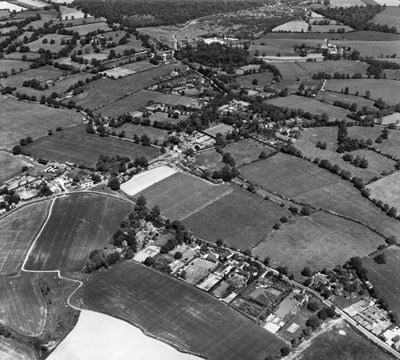
Fryerning
The village, Fryerning, 1948

Fryerning
Huskards and the village, Fryerning, 1948
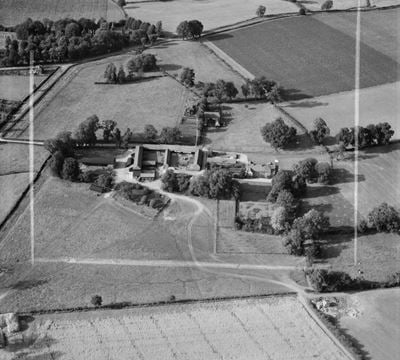
Panfield
Panfield Hall, Panfield, 1950
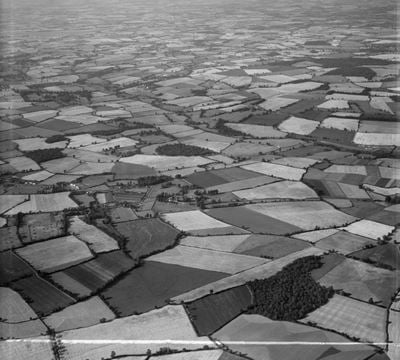
Panfield
Countryside north-west of Braintree, Panfield, 1950

Brightlingsea
The wharf and the town, Brightlingsea, 1925

Brightlingsea
Brightlingsea Creek, the waterfront and town, Brightlingsea, 1953
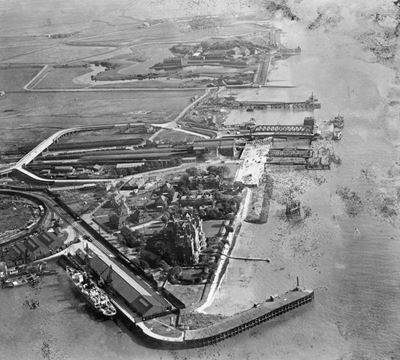
Tilbury
The Tilbury Hotel, railway station and waterfront, with Tilbury Fort in the distance, Tilbury, 1928
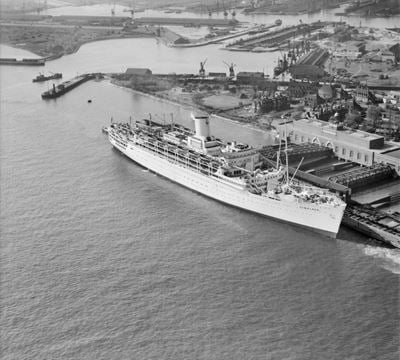
Tilbury
The SS Himalaya at the Landing Stage of Tilbury Docks, Tilbury, 1950

Thorpe-Le-Soken
Thorpe Hall and gardens, Thorpe-le-Soken, 1947
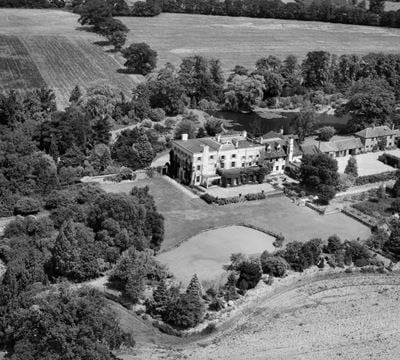
Thorpe-Le-Soken
Thorpe Hall and gardens, Thorpe-le-Soken, 1947
Essex in the Historic England Archive
The Historic England Archive cares for over 15 million images, dating from the 1850s to the present day. Discover stunning images of Essex's past. Skip this section and go to stories about heritage
Charles George Harper Collection
South Benfleet, Castle Point, Essex
Date created: 1892 - 1933
Looking across the Benfleet Creek towards South Benfleet
Eric de Mare
Shell Haven, Stanford Le Hope, Thurrock
Date created: 1945 - 1980
General view of the Shell Haven oil refinery.
John Gay Collection: London
Thurrock
Date created: 1955 - 1965
A view of buildings in an industrial dockyard, with a warehouse to left and cranes in the background.
John Gay Collection: Modern Architects
Orsett, Thurrock
Date created: 1970 - 1979
Looking from the churchyard across the High Road, Orsett, towards Conservation House, a modern brick and weatherboard house adjoining a 15th century...
John Gay Collection: Rural Life
Finchingfield Village, Braintree, Essex
Date created: 1958
A policeman leaning on his bicycle whilst talking to a lady at Finchingfield village fair. Morris dancers are visible in the background
John Gay Collection: Miscellaneous
Epping Forest, Essex
Date created: 1977 - 1978
A burr on the gnarled trunk of a tree in Epping Forest
John Gay Collection: Counties
Frinton-On-Sea, Tendring, Essex
Date created: 1949
A young girl playing at the waters edge on the beach at Frinton
John Laing Collection
Purfleet, Thurrock
Date created: Mar 1975
A view of pipework at the Esso oil refinery in Purfleet
Alfred Newton and Sons
South Weald, Brentwood, Brentwood, Essex
Date created: May 1902
GENERAL VIEW OF PLOUGH AND TWO HORSES IN FIELD
Nigel Temple Collection of Postcards of Parks and Gardens
Chalkwell Park, Southend-On-Sea, Southend-On-Sea
Date created: 1905 - 1914
GENERAL VIEW OF ROSE GARDENS
John Laing Collection
Purfleet, Thurrock
Date created: 03 Jan 1975
A view of pipework at the Esso oil refinery in Purfleet
Nigel Temple Collection of Postcards of Parks and Gardens
Southend-On-Sea
Date created: 1900 - 1940
GENERAL VIEW IN NEVER NEVER LAND
Stories about heritage in your local area
Historic England publishes news, blogs, research, videos, and podcasts celebrating England's rich heritage. Discover the stories we have about Essex. Skip this section and go to education
30 New Projects Explore England’s Rural and CoastalWorking-Class Heritage
Mentions Essex
Funded by Historic England's Everyday Heritage grants programme, these projects will explore untold stories and celebrate the heart of our history.
New Roof and Repairs for Medieval Upminster Tithe Barn
Mentions Essex
A 12 month project is underway to save the 15th century Upminster Tithe Barn in partnership with National Highways and the London Borough of Havering.
How Did Shakespeare Hide the Truth Behind the Wars of the Roses Battlefields?
Mentions Battle of Maldon 991
Discover the myths and realities of England's historic battlefields in the Wars of the Roses as we celebrate the 30th anniversary of their register.
What Was the Capital of England Before London?
Mentions Colchester Castle and the Temple of Claudius, Town Wall
London is England’s capital city now, but when was it founded? And what was the capital of England before London?
Groundbreaking English Women of Science
Mentions St John's Abbey Gatehouse
Discover the lives of women who impacted scientific discoveries in England's history, such as Marie Stopes and codebreaker Joan Clarke.
7 Places Connected to Witchcraft in England
Mentions Colchester Castle and the Temple of Claudius
Discover the places associated with witchcraft in England including Colchester Castle, Mother Shipton's Cave, Pendle Hill and York Castle Prison.
English High Street Architecture Through the Ages
Mentions 2, Stoney Lane
Explore how the architecture of the English high street has evolved over the centuries.
12 Places Connected to Queen Elizabeth I
Mentions Tilbury Fort
Discover the locations where Queen Elizabeth I lived and visited, including Hampton Court Palace, Hatfield House and Kenilworth Castle.
Boudica’s Revolt Against Rome
Mentions Colchester Castle and the Temple of Claudius
Discover the life of Boudica, or Boadicea, the Warrior Queen and leader of the Iceni tribe
16 Historic Gardens and Landscapes to Visit
Mentions Audley End
Try these English gardens if you’re looking for somewhere with spectacular garden scenery.
What Is the Oldest Building in England?
Mentions Remains of an apsidal Roman building at Butt Road and Southway
From the oldest church to archaeological remains, here are the contenders for England's oldest building.
What Are Hulks?
Mentions Mud Berth for CGWV No 7 (formerly HMS Beagle)
Discover some of the abandoned ships that line England’s coast and rivers.
Why Exercising in Historic Green Spaces is Good for Your Mental (and Physical) Health
Mentions Wivenhoe Park
Explore the benefits of historic public parks and green spaces across England.
Historic North Sea Floods
Mentions Martello tower C, St Osyth Beach, Clacton-on-Sea
The 1953 East Coast floods and other major historic floods that have impacted coastal England over the last 1,000 years.
The 'London' Wreck – Excavation and Analysis of Material at Risk
Mentions Essex
Work on the 'London' wreck has revealed a wealth of information about this 17th-century warship.
The London Wreck: A Kaleidoscope of Specialists, Materials and Artefacts
Mentions Essex
Scientific analysis of the finds from the wreck of the London has revealed a wealth of information about life aboard a 17th century Royal Navy Vessel.
Planting Trees for the Future Whilst Protecting the Past
Mentions Essex
Developing new datasets to ensure that the right tree is planted in the right place.
Grant to Secure the Future of Colchester's Iconic Jumbo Water Tower
Mentions Municipal Water Tower (Jumbo), Essex
Historic England has awarded a grant of £550,000 to repair and restore the Jumbo Municipal Water Tower in Colchester, Essex.
30 New Projects Explore England’s Rural and CoastalWorking-Class Heritage
Mentions Essex
Funded by Historic England's Everyday Heritage grants programme, these projects will explore untold stories and celebrate the heart of our history.
New Roof and Repairs for Medieval Upminster Tithe Barn
Mentions Essex
A 12 month project is underway to save the 15th century Upminster Tithe Barn in partnership with National Highways and the London Borough of Havering.
£1.6 Million Grant to Restore Thaxted Windmill, Essex
Mentions Essex
The National Lottery Heritage Fund and Historic England have given grant funding to repair and restore the building and its millwrighting machinery.
New Project Celebrates the Coastal Heritage of Great Yarmouth, Harwich and Orford Ness
Mentions Essex
'Collecting Dreams, Shifting Futures' is a story-gathering project uniting communities in Great Yarmouth, Harwich and Orford Ness.
17 Remarkable Historic Places Listed in 2024
Mentions 16 Warley Way, Tomb of Mary Ellis in St Clement's Church, Tomb of William Goodlad in St Clement's Church
Celebrating 17 historic gems that were examined, protected and added to the National Heritage List for England in 2024.
Archaeological Sensitivity Mapping
Mentions Essex
Developing a methodology for understanding where future significant archaeological discoveries may be made.
London Archaeology and Characterisation
Mentions Essex
The challenges of managing change in complex townscapes and time-depth.
New Funding to Celebrate Rural and Coastal Working-Class Heritage
Mentions Essex
Historic England is funding new projects to explore untold stories and celebrate the people and places at the heart of our history.
Essex's social history through photos
Over 10,000 images from the Historic England Archive have been specially selected and re-captioned for teachers, students, and anyone who wants to learn more about their local area. Skip this section and go to grant-aided places
Writtle Green, The Green, Writtle, Essex
Period: 1950s (1950 - 1959)
Children play beside the pond on Writtle Green, with 20 and 22 The Green in the background to the north.
Writtle Green, The Green, Writtle, Essex
Workshop, Bradwell On Sea, Essex
Period: Georgian (1714 - 1836)
This building was built in the 18th century. It was formerly a Bentall and Maldon Smithy and now is used as several workshops.
Workshop, Bradwell On Sea, Essex
Workmen rebuilding flood defences with sandbags at Coryton Oil Refinery, Coryton, Thurrock
Period: 1950s (1950 - 1959)
The North Sea Flood of 1953 struck on the night of Saturday 31st January through to the morning of Sunday 1st February.
Workmen rebuilding flood defences with sandbags at Coryton Oil Refinery, Coryton, Thurrock
Workmen rebuilding flood defences with sandbags at Coryton Oil Refinery, Coryton, Thurrock
Period: 1950s (1950 - 1959)
The North Sea Flood of 1953 struck on the night of Saturday 31st January through to the morning of Sunday 1st February.
Workmen rebuilding flood defences with sandbags at Coryton Oil Refinery, Coryton, Thurrock
Workhouse, now St Albright's Hospital, Colchester, Essex
Period: Victorian (1837 - 1901)
Lexden and Winstree workhouse was built in 1837 to an approved plan.
Workhouse, now St Albright's Hospital, Colchester, Essex
Woolmarket House, Horndon-on-the-Hill, Thurrock
Period: Medieval (Middle Ages) (1066 - 1484)
The Old Market Hall (formerly listed as Woolmarket House) was built in the 14th century. It has had extensive later alterations and modernisation.
Woolmarket House, Horndon-on-the-Hill, Thurrock
Windmill, Braintree, Essex
Period: Stuart (1603 - 1713)
This is a fine post mill with sails. It dates from 1680. The mill was moved to its present site in 1830.
Windmill, Braintree, Essex
Weald Hall, Brentwood, Essex
Period: Victorian (1837 - 1901)
The south front of Weald Hall with a horse-drawn carriage at the entrance. The house was constructed around 1540-50 with additions around 1560-70.
Weald Hall, Brentwood, Essex
Visit grant-aided places near you
These places and buildings have been helped by Historic England's financial grants. Find local heritage in your neighbourhood that you never knew existed! Please note that opening times may vary. Skip this section and go to related locations
Creeksea Place, 826 Ferry Rd, Burnham-on-Crouch, Essex
Grade II*- listed Creeksea Place, part of a large 16th-century red brick house completed in 1569, stands in a 30-acre park.
Electric Palace Cinema, King's Quay, Harwich, Essex
Built in 1911, the Electric Palace is one of the world's oldest, and least altered, purpose-built cinemas.
Harwich Treadwheel Crane, Harwich, Essex
The Treadwheel Crane is a two-storey, timber-framed, roofed structure housing two treadwheels that operated a timber crane.
Naze Tower, The Naze, Old Hall Lane, Walton-on-the-Naze, Essex
The 86ft-high brick Naze Tower is a navigation tower built for Trinity House in 1720.
Saffron Walden Castle, Saffron Walden, Essex
Walden Castle, a medieval fortress in Essex, was constructed during the 12th century. Today, only the ruined core of the castle remains.
The Plume Library, First Floor, Plume Building, Market Hill, Maldon
Thomas Plume’s Library was founded in 1704 under the terms of the will of Dr Thomas Plume, Vicar of Greenwich and Archdeacon of Rochester, who had...
Discover more
Ready for more local stories? Take a look at these other places nearby


